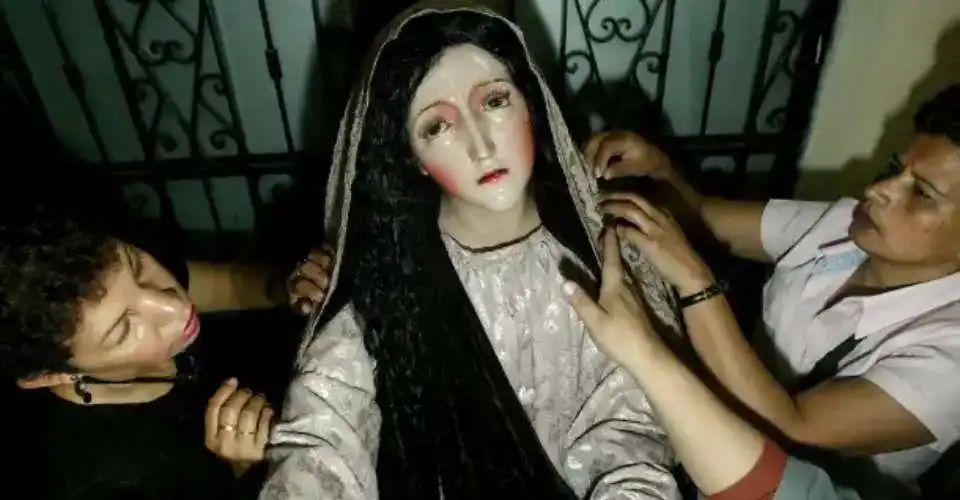Women's witness illuminates the path of Christian faith
There is something profoundly instructive about the women's faithful presence at the tomb
Apr 15, 2025

By Dr. John Singarayar
In the soft haze of dawn, as the world held its breath between darkness and light, Mary Magdalene walked alone toward a tomb. Her heart heavy with grief, she carried spices to anoint a body, expecting to find death.
Instead, she encountered the greatest mystery of faith: an empty tomb and a risen Lord.
"Woman, why are you weeping? Whom are you seeking?" The question rings across millennia. It was to her — not to Peter, not to John, not to any man — that Christ first revealed himself in resurrection glory.
It was her name that was the first word spoken by the risen Lord. And it was her voice — a woman's voice — that first proclaimed the Easter message: "I have seen the Lord."
This profound truth often passes us by without the weight it deserves. In a patriarchal world, God chose a woman as the primary witness to the central event of Christian faith.
Mary Magdalene stands as the apostle to the apostles, the first evangelist of resurrection reality. This was not incidental but intentional — a divine statement written into the very narrative of salvation.
Mary was not alone in her faithful vigil. The Gospels record various women who followed Jesus throughout his ministry, who stayed at the cross when male disciples fled, who watched where his body was laid, and who returned to properly care for him even in death.
These women — Mary Magdalene, Joanna, Mary the mother of James, Salome, and others unnamed — form a constellation of faithful witness around the resurrection event.
Their presence disturbs the expected narrative.
In ancient Jewish law, women were not considered reliable witnesses in legal proceedings. Their testimony carried little weight in public discourse.
Yet the Gospel writers unflinchingly record that women were the first witnesses to the resurrection — a detail that would have undermined rather than strengthened their case in the ancient world. They included this detail not because of its cultural liability but because of its unassailable truth.
The women were there. The women saw. The women testified.
This reveals a divine preference for inverting human hierarchies, for elevating the marginalized, for speaking through those society has silenced. The stone that the builders rejected has become the cornerstone — and the witnesses that society rejected became the first heralds of resurrection.
There is something profoundly instructive about the women's faithful presence at the tomb. When others abandoned hope, they remained. When others scattered in fear, they gathered in love. When others prioritized safety, they chose service.
Their vigil teaches us about the spiritual practice of faithful waiting — of being present when all seems lost, of tending to what appears dead, of honoring what others have abandoned. They did not know resurrection was coming. They came to anoint a corpse, to perform the final acts of care. Yet in this humble act of presence, they positioned themselves to witness glory.
Mary Magdalene's encounter follows a pattern that becomes the template for Christian discipleship: she sees the risen Lord, and she is immediately sent to tell others. Her commissioning is direct: "Go to my brothers and say to them, 'I am ascending to my Father and your Father, to my God and your God.'"
This "see and send" pattern reveals the essentially outward-moving, testimonial nature of Christian faith. Authentic encounters with the divine do not terminate in private spiritual experience but propel us outward as witnesses.
Here we find another inversion of expected power structures. The male disciples, who had walked with Jesus throughout his ministry, now receive the resurrection news from a woman. They must humble themselves to hear and believe her testimony.
The traditional teaching hierarchy is temporarily but significantly reversed — the men must learn from the woman about the resurrection's reality.
For centuries, Mary Magdalene's witness has been obscured by misinterpretation. She was conflated with the anonymous sinful woman who anointed Jesus' feet, with Mary of Bethany, and with various other women in the Gospel narratives. From these mistaken conflations arose the persistent image of Mary Magdalene as a reformed prostitute — a characterization with no biblical basis.
The Gospels identify her clearly: she was a woman from whom Jesus had cast out seven demons, who supported his ministry financially, who stood by the cross, who observed his burial, and who discovered the empty tomb.
She was, in essence, a faithful disciple, a financial supporter, and ultimately, the primary resurrection witness.
Why has her image been so persistently distorted? Perhaps because a faithful, financially independent woman who received direct revelation from the risen Christ and instructed male apostles challenges too many conventional hierarchies. It has often seemed easier to sexualize her, to emphasize her supposed sinfulness, than to wrestle with the implications of her apostolic role.
Mary Magdalene stands at the head of a long line of women who have carried the torch of faith through history, often against tremendous resistance. From the wealthy women who supported the early church, to the desert mothers who pioneered Christian monasticism, to the medieval mystics who deepened Christian spirituality, to the missionaries who carried the gospel across cultural boundaries, women have been indispensable to Christianity's survival and flourishing.
Yet their stories have often been marginalized, their contributions minimized, their authority questioned. The pattern established at the resurrection — where women's testimony was initially dismissed as "idle tales" — has repeated throughout church history.
Despite this resistance, women have persisted as torch bearers of faith. Like Mary running from the tomb with uncontainable news, generations of women have refused to be silenced.
What might the church look like if it fully embraced the resurrection pattern of women's witness? What might Christian community become if it recognized that gender hierarchy was the first thing the risen Christ dismantled?
A church illuminated by women's full participation would not simply add women to existing structures but would be transformed by their distinctive gifts, perspectives, and experiences.
In my own spiritual journey, Mary Magdalene has become a companion and guide. Her story reminds me that authentic faith often begins in places of deep wounding and healing. Her witness challenges me to remain present even when hope seems lost.
And the moment of recognition — when Jesus simply speaks her name, "Mary" — reminds me that a divine encounter often comes not through spectacular displays but through the intimate knowing that can only exist between beings who truly see each other.
When I feel unseen in my own spiritual journey, I remember the woman in the garden who was seen, named, and sent. I remember that the resurrection narrative itself stands as God's eternal validation of women's spiritual witness. And I find courage to continue bearing the torch of faith, joining my light with the countless women who have illuminated the way before me, and for those who will carry the flame forward into futures I cannot yet imagine.--ucanews.com







Total Comments:0